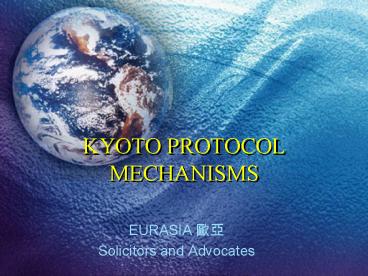KYOTO PROTOCOL MECHANISMS - PowerPoint PPT Presentation
Title:
KYOTO PROTOCOL MECHANISMS
Description:
KYOTO PROTOCOL MECHANISMS EURASIA Solicitors and Advocates What is the Kyoto Protocol? The Kyoto Protocol is an agreement made under the United Nations ... – PowerPoint PPT presentation
Number of Views:106
Avg rating:3.0/5.0
Title: KYOTO PROTOCOL MECHANISMS
1
KYOTO PROTOCOL MECHANISMS
- EURASIA ??
- Solicitors and Advocates
2
What is the Kyoto Protocol?
- The Kyoto Protocol is an agreement made under the
United Nations Framework Convention on Climate
Change (UNFCCC). Countries that ratify this
protocol commit to reduce their emissions of
carbon dioxide and five other greenhouse gases,
or engage in emissions trading if they maintain
or increase emissions of these gases to a 5.37
less than 1999.
3
KYOTO PROTOCOL PARTIES
- ANNEX 1 Countries
- Developed countries
- Non- ANNEX 1 Countries
- Non Developed countries
4
Flexibility Mechanisms
- The Kyoto Protocol defines three innovative
flexibility mechanisms to lower the overall
costs of achieving its emissions targets. - These mechanisms enable Parties to access
cost-effective opportunities to reduce emissions
or to remove carbon from the atmosphere in other
countries. - While the cost of limiting emissions varies
considerably from region to region, the benefit
for the atmosphere is the same, wherever the
action is taken. - Under this system, the amount to which an Annex I
Party must reduce its emissions over the five
year commitment period (assigned amount) is
divided into units each equal to one ton of
carbon dioxide equivalent.
5
Kyoto mechanisms are
- CDM Clean Development Mechanism.- provides for
Annex I Parties to implement projects that reduce
emissions in non-Annex I Parties, or absorb
carbon through afforestation or reforestation
activities, in return for certified emission
reductions (CERs, tCERs and lCERs) and assist the
host Parties in achieving sustainable development
and contributing to the ultimate objective of the
Convention. - JI Joint Implementation.- an Annex I Party may
implement an emission-reducing project or a
project that enhances removals by sinks in the
territory of another Annex I Party (with a
commitment inscribed in Annex B of the Kyoto
Protocol) and count the resulting emission
reduction units (ERUs) towards meeting its own
Kyoto target.
6
The clean development mechanism (CDM)
- Provides for Annex I Parties to implement project
activities that reduce emissions in non-Annex I
Parties, in return for certified emission
reductions (CERs). - The CERs generated by such project activities can
be used by Annex I Parties to help meet their
emissions targets under the Kyoto Protocol. - Such project activities are to assist the
developing country host Parties in achieving
sustainable development and in contributing to
the ultimate objective of the Convention.
7
Emissions trading (or cap and trade)
- Is an administrative approach used to control
pollution by providing economic incentives for
achieving reductions in the emissions of
pollutants. - A central authority (usually a government agency)
sets a limit or cap on the amount of a pollutant
that can be emitted. Companies or other groups
that emit the pollutant are given credits or
allowances which represent the right to emit a
specific amount. The total amount of credits
cannot exceed the cap, limiting total emissions
to that level. - Companies that pollute beyond their allowances
must buy credits from those who pollute less than
their allowances. - This transfer is referred to as a trade. In
effect, the buyer is being fined for polluting,
while the seller is being rewarded for having
reduced emissions. The more firms that need to
buy credits, the higher the price of credits
becomes -- which makes reducing emissions
cost-effective in comparison.
8
How de process works in South America
- In any Annex 1 Country the cost of reducing one
ton a year of Co2 is USD 200-500. - Specialized brokers seek projects in Non Annex 1
countries to reduce emissions. The whole process
takes 8 to 16 months.
- Presentation of the Project Idea Note or PIN in
the Ministry of the Environment or the related
governmental organism. - The organism will issue the Project Design
Document or PDD. - Audit of the process to certify the amount of Co2
that will be reduced.
9
Continuation of the Process on the United Nations
Development Programme or UNDP
- After checking that the process will reduce the
projected Co2 over the next 6 years the UNPD
emits the certificates. - The Certificates may be negotiated by the owner.
- The ownership depends on the sponsor of the
program. There are 3 kinds of ownership.
10
Ownership of Certificates
- The company assumes every costs and risks and
freely negotiates the Certificates at USD 15-20
Ton/year, depending of the market prices. - The company pre sells the Certificates and
receives partial help from the buyer (country or
broker) at USD 7-9 /ton/year - The company pre sells the whole package and
receives the agreed price USD 4-5 /ton/year.
11
FINAL WORDS
- Because the market is constantly changing it is
similar to a stock market. - In order to have an attractive project it's
required a minimum of 10.000 ton CO2 annually.
12
THANK YOU!
- Please feel free to contact for any further
details!































